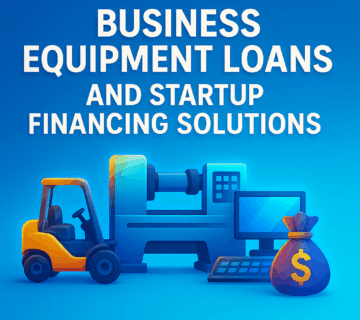Fuel Your Startup’s Growth with Equipment Financing

Launching a startup is both an exciting and challenging journey, often accompanied by substantial investments in essential tools and technology. For new businesses facing budget constraints, Equipment Financing provides a practical way to acquire necessary resources without exhausting limited capital. This guide is designed to walk you through how flexible equipment financing and flexible equipment leasing can fuel your growth, preserve cash flow, and position your startup for success.
1. Introduction to Equipment Financing
Startups often need substantial equipment to get off the ground—whether it’s machinery, computers, or manufacturing tools. Equipment financing allows new businesses to secure necessary equipment without the burden of hefty upfront costs. This form of financing enables startups to make regular payments over time, ensuring they can allocate their financial resources towards growth-related initiatives while still having the tools they need to operate effectively.
2. Why Equipment Financing is Ideal for Startups
Startups typically have limited capital, uncertain revenue streams, and a strong need to invest in tools that streamline operations and drive growth. Equipment financing bridges this gap by allowing startups to purchase equipment and spread the cost over several months or years. Rather than compromising on the quality of equipment, financing allows startups to choose the best options that will increase efficiency, reduce labor costs, and improve the quality of goods or services offered.
3. Understanding Flexible Equipment Financing and Leasing
Flexible equipment financing is designed to provide startups with manageable payments that align with their financial goals and cash flow. Unlike traditional loans with rigid terms, flexible financing options allow startups to adjust payments or refinance terms as needed. Flexible equipment leasing works similarly, providing the added benefit of allowing businesses to lease equipment on a temporary basis. Leasing provides an ideal solution for equipment that may need frequent upgrades, like technology, or that has a limited lifespan.
4. Types of Equipment That Can Be Financed
Equipment financing is available across numerous sectors and covers a broad spectrum of items:
- Manufacturing: industrial machines, automated tools, and safety equipment.
- Technology: laptops, servers, software, and networking hardware.
- Construction: Excavators, bulldozers, cranes, and other heavy machinery.
- Healthcare: diagnostic machines, patient care devices, and lab equipment.
- Retail: Point-of-sale systems, shelving, display counters, and refrigerators.
- Agriculture: Tractors, irrigation systems, and processing equipment.
5. How Does Equipment Financing Work?
Equipment financing typically involves a loan or lease agreement where the lender provides the funds to purchase equipment, while the startup repays it over time, generally through fixed monthly installments. The equipment itself often serves as collateral, which allows lenders to offer lower interest rates since the equipment secures the loan. Depending on the agreement, the startup may own the equipment outright after making all payments or may need to negotiate further terms if the item was leased.
6. Key Benefits of Equipment Financing for Startups
Cash Flow Management
Instead of a large one-time payment, equipment financing allows startups to break down costs over manageable monthly installments. This approach conserves cash flow, allowing businesses to allocate funds towards other essential areas like marketing, product development, or payroll.
Tax Benefits
Equipment financing can lead to significant tax savings. Certain financing arrangements qualify for tax deductions on interest paid, while others allow deductions on depreciation. Startups can explore potential tax benefits with their accountants to maximize their financing impact.
Access to Advanced Equipment
Financing opens doors to premium equipment that startups might not otherwise be able to afford. Accessing better-quality equipment translates to higher productivity and efficiency, enabling startups to compete more effectively in their markets.
Simplified Budgeting
With fixed monthly payments, startups can more accurately project their expenses. Predictable payments make it easier to manage budgets and prevent unexpected cost overruns, contributing to a more stable financial outlook.
7. Comparing Equipment Financing and Flexible Equipment Leasing
In equipment financing, businesses gradually gain ownership of the equipment over time. This option is generally favorable for equipment with a long lifespan, as it builds toward eventual ownership, freeing the business from recurring expenses. Flexible equipment leasing, however, is beneficial for items with shorter life cycles or for startups unsure about long-term needs. Leasing allows for more adaptable terms, with options to upgrade, renew, or return equipment at the lease’s end, making it ideal for fast-evolving industries like technology.
8. Step-by-Step Guide to Applying for Equipment Financing
- Assess Your Needs: Identify and prioritize equipment essential for operational efficiency and growth.
- Research Lenders: Look for financing providers who specialize in flexible equipment financing for startups, as they often understand the unique challenges and goals of new businesses.
- Prepare Documentation: Compile necessary documents, including a business plan, cash flow projections, and credit history.
- Apply for Financing: Submit your application with clear details on how the equipment will contribute to your growth and sustainability.
- Evaluate Terms Carefully: Review interest rates, term lengths, and any additional fees. Select an option that balances affordability with business objectives.
9. Top Sources for Equipment Financing for Startups
Startups have a range of options when it comes to equipment financing:
- Traditional Banks: Offer stable financing, although requirements can be stringent.
- Online Lenders: Known for faster approval times and flexibility, often catering to startups with unique terms.
- Leasing Companies: Provide flexible equipment leasing options across various sectors, from healthcare to construction.
- Small Business Administration (SBA): SBA-backed loans can provide favorable terms, especially for startups needing long-term financing.
10. Evaluating Interest Rates and Terms
When exploring equipment financing options, startups should carefully evaluate interest rates, which can impact monthly payments and the overall cost of financing. Factors affecting interest rates include the startup’s creditworthiness, the term length, and whether the loan is secured by collateral. Reviewing terms and interest rates from multiple lenders ensures startups can secure a financing option that matches their needs and budget.
11. Exploring the Tax Advantages of Equipment Financing
Financing equipment can yield tax benefits. The IRS Section 179 deduction allows eligible businesses to write off equipment purchases, which can provide valuable savings. Furthermore, financing structures that include interest payments may qualify for additional deductions. Consulting with a tax professional can help startups determine how best to leverage these benefits.
12. Avoiding Common Mistakes in Equipment Financing
Some common pitfalls startups encounter include:
- Borrowing Too Much Too Soon: Over-borrowing based on aggressive growth projections can strain finances if revenue doesn’t meet expectations.
- Selecting Inappropriate Terms: Using short-term financing for long-term equipment needs can lead to challenges, especially if the equipment’s lifespan extends beyond the loan term.
- Ignoring Hidden Costs: Maintenance, repairs, and insurance add to the total cost of ownership. Factoring in these costs during the financing process prevents unexpected expenses.
13. Flexible Equipment Financing Options for Tech Startups
For tech startups, flexible equipment financing provides a valuable solution to access cutting-edge technology without the burden of high upfront costs. Financing or leasing computers, servers, or specialized software helps businesses stay competitive and current without stretching their capital.
14. When to Opt for Flexible Equipment Leasing
Leasing is often advantageous for equipment that requires frequent upgrades or has a limited useful life. For startups in industries like technology or healthcare, where equipment needs evolve rapidly, leasing allows for regular updates without the added expense of purchasing. With options to renew, return, or buy equipment at the end of the lease, flexible leasing offers adaptability for changing needs.
15. FAQs: Common Questions about Equipment Financing
Q1: What credit score is required for equipment financing?
A: Many lenders look for a credit score above 600, but requirements can vary based on the lender and the type of equipment.
Q2: Can I finance used equipment?
A: Yes, used equipment is often financeable. Many lenders provide financing for used equipment, often at lower rates compared to new equipment financing.
Q3: How does equipment financing affect cash flow?
A: Equipment financing supports cash flow by spreading payments over time, allowing businesses to avoid the strain of upfront expenses.
Q4: Is equipment leasing cheaper than financing?
A: Leasing often has lower monthly costs but does not offer ownership, making it more affordable in the short term for equipment with shorter usage periods.
Q5: Can startups with limited revenue qualify for equipment financing?
A: Some lenders cater specifically to startups and may consider business plans, market potential, and projected revenue in addition to current income.
Q6: What happens if I default on an equipment financing loan?
A: Defaulting on an equipment financing loan may result in the lender reclaiming the equipment, as it often serves as collateral.
Fueling your startup’s growth with equipment financing provides a strategic pathway to acquire critical resources without depleting capital. Whether you opt for flexible equipment financing or flexible equipment leasing, understanding these options enables sustainable growth while preserving your financial stability. Consider consulting with financial advisors and comparing lenders to ensure your chosen financing solution aligns with your long-term goals.




No comment